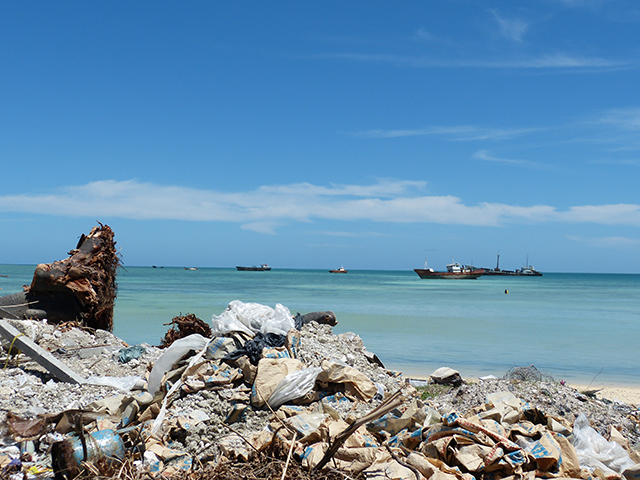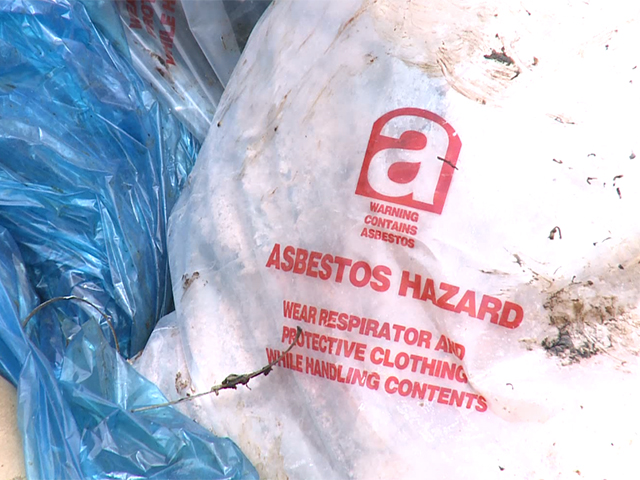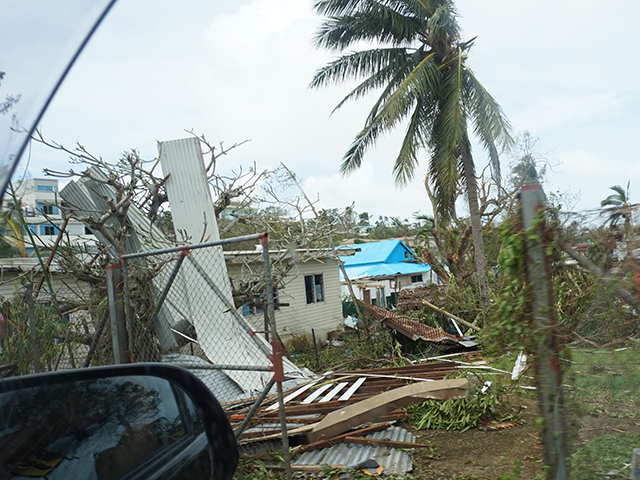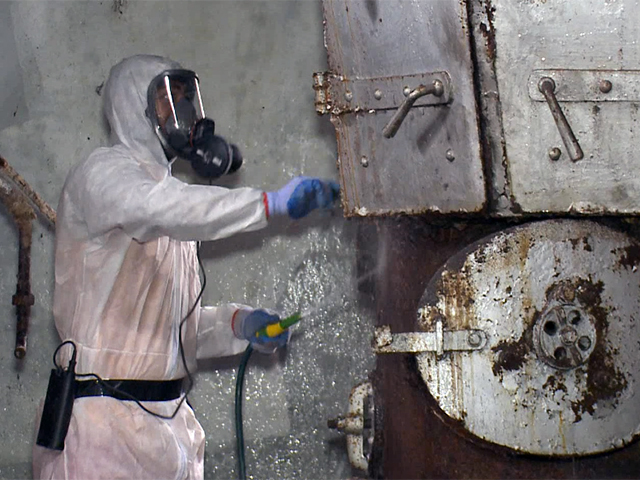
Waste Management and Pollution Control
The Pacific islands are renowned for their natural beauty. But sadly, poor waste management is a major threat to sustainable development in Pacific island countries and territories. It has negative impacts on biodiversity, water quality, fisheries, agriculture, tourism and quality of life in general. Notably, some types of waste also pose a grave threat to human health.
A partnership between the European Union and the Secretariat of the Pacific Regional Environment Programme (SPREP) promises to address some of the Pacific region's most pressing, and dangerous, waste issues.

The Pacific Hazardous Waste project, known as PacWaste, is a €7.85 million, four year project, funded by the European Union and implemented by SPREP to improve the management of hazardous waste across the Pacific region.
One of the hazardous forms of waste that PacWaste is targeting is asbestos - a naturally occurring fibrous mineral that was once commonly used in building materials, insulation, brake linings, roofing products, and electrical and other consumer products.
SPREP's PacWaste Project Manager, Mr Stewart Williams, explains:
"When products containing asbestos are damaged or wear down over time, small fibres can be released and become airborne where they can be inhaled. Although these fibres are not immediately toxic, they can remain lodged in the lung tissue and can eventually cause serious lung disease including asbestosis, lung and other cancers many years after inhalation."

To minimise the risk of asbestos exposure to individuals and communities, PacWaste is working to identify and prioritise the removal of this hazardous material in 13 countries across the Pacific where asbestos poses a serious risk.
Recently, the project reached a major milestone with the completion of the most comprehensive region-wide asbestos baseline survey conducted to date in the Pacific. These surveys involved visual asbestos assessments of many thousands of government, commercial and residential buildings, including hospitals, schools and other public places, followed by comprehensive asbestos sampling and analysis in 26 different islands across 13 Pacific Island countries. This process was used to determine locations of asbestos and identity the level of risk to human health.
The baseline surveys have already shown their value in reducing human exposure to harmful asbestos.
Following the devastation caused by Tropical Cyclone Pam and associated severe weather events, PacWaste was able to provide these valuable inventories of hazardous asbestos to disaster coordinators from the United Nations Office for the Coordination of Humanitarian Affairs (OCHA).

Mr Jesús Laviña, Head of Section for Natural Resources and Infrastructure at the European Union Delegation for the Pacific, Suva, explains:
"These reports for Vanuatu, Tuvalu and Kiribati, contain the confirmed location of public and commercial buildings with asbestos as well as the percentage of residential premises that can be expected to contain asbestos building materials. This information is vital to cleanup crews who can use the information to avoid such premises if they have been damaged, or to conduct any cleanup using approaches that will safeguard their health."
During the Fiji asbestos survey, PacWaste experts identified high risk friable asbestos fibres at the Tamavua Twomey Hospital in Suva. After the asbestos risk was identified, PacWaste worked immediately to arrange an emergency clean-up of the hospital. Fast action and rigorous safety measures were paramount, to protect the health of emergency and hospital workers.
Within days, PacWaste had successfully removed the most dangerous asbestos from the hospital. This ensured that the staff and patients at Tamavua Twomey Hospital had peace of mind.
Mr Niumaia Tule, who works as a boiler operator at the hospital, explains:
"For years we've been trying to get rid of this white stuff in the boiler, and nobody knew how to get rid of it. We knew it was bad for our health. So these people came up, they brought their equipment, their body suits and all this safety equipment, they got rid of it. We've got a clean environment now and it's better to look at."

With all the asbestos surveys complete, and the emergency clean-up at the Tamavua Hospital a success, PacWaste will now look at how best to remove other - less urgent - instances of asbestos occurrence in Fiji and across the Pacific islands.
Asbestos is one of four focus areas for PacWaste - the others include E-Waste, healthcare waste and atoll solid waste management. Through prioritising the improved management of hazardous waste and materials, the European Union and SPREP are making the Pacific islands a safer and cleaner place for all.
---
For further information about the 2015 European Year for Development, please visit:
https://europa.eu/eyd2015/en
For more information about PacWaste, please visit: www.sprep.org/pacwaste
A partnership between the European Union and the Secretariat of the Pacific Regional Environment Programme (SPREP) promises to address some of the Pacific region's most pressing, and dangerous, waste issues.

Poor waste management is a major threat to sustainable development in the Pacific region. Photo: C.Iacovino/SPREP
The Pacific Hazardous Waste project, known as PacWaste, is a €7.85 million, four year project, funded by the European Union and implemented by SPREP to improve the management of hazardous waste across the Pacific region.
One of the hazardous forms of waste that PacWaste is targeting is asbestos - a naturally occurring fibrous mineral that was once commonly used in building materials, insulation, brake linings, roofing products, and electrical and other consumer products.
SPREP's PacWaste Project Manager, Mr Stewart Williams, explains:
"When products containing asbestos are damaged or wear down over time, small fibres can be released and become airborne where they can be inhaled. Although these fibres are not immediately toxic, they can remain lodged in the lung tissue and can eventually cause serious lung disease including asbestosis, lung and other cancers many years after inhalation."

Asbestos is now banned from most modern products as it has been found to be a major threat to human health. Photo: Amol Lal
To minimise the risk of asbestos exposure to individuals and communities, PacWaste is working to identify and prioritise the removal of this hazardous material in 13 countries across the Pacific where asbestos poses a serious risk.
Recently, the project reached a major milestone with the completion of the most comprehensive region-wide asbestos baseline survey conducted to date in the Pacific. These surveys involved visual asbestos assessments of many thousands of government, commercial and residential buildings, including hospitals, schools and other public places, followed by comprehensive asbestos sampling and analysis in 26 different islands across 13 Pacific Island countries. This process was used to determine locations of asbestos and identity the level of risk to human health.
The baseline surveys have already shown their value in reducing human exposure to harmful asbestos.
Following the devastation caused by Tropical Cyclone Pam and associated severe weather events, PacWaste was able to provide these valuable inventories of hazardous asbestos to disaster coordinators from the United Nations Office for the Coordination of Humanitarian Affairs (OCHA).

In Vanuatu, after the destruction caused by Tropical Cyclone Pam, disaster coordinators used PacWaste asbestos surveys to safeguard the health of communities and clean-up crews. Photo: C.Siota/SPREP
Mr Jesús Laviña, Head of Section for Natural Resources and Infrastructure at the European Union Delegation for the Pacific, Suva, explains:
"These reports for Vanuatu, Tuvalu and Kiribati, contain the confirmed location of public and commercial buildings with asbestos as well as the percentage of residential premises that can be expected to contain asbestos building materials. This information is vital to cleanup crews who can use the information to avoid such premises if they have been damaged, or to conduct any cleanup using approaches that will safeguard their health."
During the Fiji asbestos survey, PacWaste experts identified high risk friable asbestos fibres at the Tamavua Twomey Hospital in Suva. After the asbestos risk was identified, PacWaste worked immediately to arrange an emergency clean-up of the hospital. Fast action and rigorous safety measures were paramount, to protect the health of emergency and hospital workers.
Within days, PacWaste had successfully removed the most dangerous asbestos from the hospital. This ensured that the staff and patients at Tamavua Twomey Hospital had peace of mind.
Mr Niumaia Tule, who works as a boiler operator at the hospital, explains:
"For years we've been trying to get rid of this white stuff in the boiler, and nobody knew how to get rid of it. We knew it was bad for our health. So these people came up, they brought their equipment, their body suits and all this safety equipment, they got rid of it. We've got a clean environment now and it's better to look at."

Asbestos disposal experts rid the Tamavua Twomey hospital boiler of asbestos. Photo: Amol Lal
With all the asbestos surveys complete, and the emergency clean-up at the Tamavua Hospital a success, PacWaste will now look at how best to remove other - less urgent - instances of asbestos occurrence in Fiji and across the Pacific islands.
Asbestos is one of four focus areas for PacWaste - the others include E-Waste, healthcare waste and atoll solid waste management. Through prioritising the improved management of hazardous waste and materials, the European Union and SPREP are making the Pacific islands a safer and cleaner place for all.
---
For further information about the 2015 European Year for Development, please visit:
https://europa.eu/eyd2015/en
For more information about PacWaste, please visit: www.sprep.org/pacwaste